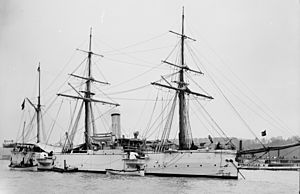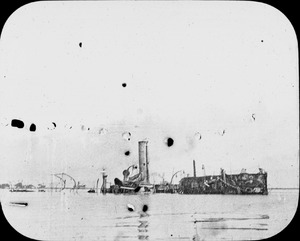Spanish cruiser Don Juan de Austria facts for kids
class="infobox " style="float: right; clear: right; width: 315px; border-spacing: 2px; text-align: left; font-size: 90%;"
| colspan="2" style="text-align: center; font-size: 90%; line-height: 1.5em;" | 
|} The Don Juan de Austria was a type of warship called an unprotected cruiser in the Spanish Navy. It was part of the Velasco class of ships. This ship became famous for its role in the Battle of Manila Bay during the Spanish–American War.
Contents
| History | |
|---|---|
| Name | Don Juan de Austria |
| Namesake | John of Austria |
| Builder | Naval shipyard, Cartagena, Spain |
| Laid down | 1883 |
| Launched | 23 January 1887 |
| Completed | 1888 or 1889 |
| Fate | Sunk 1 May 1898; captured and salvaged by U.S. Navy |
| General characteristics | |
| Class and type | Velasco-class unprotected cruiser |
| Displacement | 1,152 tons |
| Length | 210 ft 0 in (64.01 m) |
| Beam | 32 ft 0 in (9.75 m) |
| Draft | 13 ft 8 in (4.17 m) maximum |
| Installed power | 1,500 ihp (1,100 kW) |
| Propulsion | 1-shaft, horizontal compound, 4-cylinder boilers |
| Sail plan | Barque-rigged |
| Speed | 13 knots (24 km/h; 15 mph) |
| Complement | 173 officers and enlisted |
| Armament |
|
| Notes | 200 to 220 tons of coal (normal) |
Ship Design and Features
The Don Juan de Austria was built in Cartagena, Spain, at a naval shipyard. Its construction began in 1883, and it was officially launched into the water on January 23, 1887. The ship was finished and ready for service by 1888 or 1889.
This cruiser had a strong iron hull. It also had a tall smokestack and was designed to use sails, like a barque, in addition to its engines. This allowed it to travel long distances even without using much fuel.
Journey to the Philippines
Joining the "Black Squadron"
In March 1890, a Spanish naval officer named Manuel de la Cámara took charge of a special group of ships. This group included the Don Juan de Austria and two other cruisers, the Castilla and the Don Antonio de Ulloa. Their mission was to travel to the Philippines to make the Spanish Navy's forces there stronger.
The ships left Spain in April 1890. They sailed through the Mediterranean Sea, the Suez Canal, and the Indian Ocean. They stopped at several ports, including Barcelona, Port Said, and Singapore. Finally, they arrived in Manila on June 17, 1890.
This group of ships became known as the "Black Squadron." This was because they were painted black, unlike the other Spanish ships in Asia, which were white.
Preparing for War
The Don Juan de Austria stayed in the Philippines. In April 1898, the Spanish–American War began. The ship was then part of the Spanish fleet in Manila Bay, led by Rear Admiral Patricio Montojo.
On April 25, 1898, the Don Juan de Austria and five other ships sailed to Subic Bay. Admiral Montojo hoped to use underwater mines and shore cannons there to protect his fleet from the U.S. Navy. However, when they arrived, they found that most of the mines were not laid, and the cannons were not ready.
So, on April 29, the ships returned to Manila Bay. Montojo believed the shallow waters and shore cannons there would offer better protection. The fleet anchored near Cavite Peninsula. The Don Juan de Austria quickly went to Manila to get small boats and barges. These were tied to the wooden cruiser Castilla to help protect it from enemy fire.
Battle of Manila Bay
First Sightings
Early on the morning of May 1, 1898, the U.S. Navy's fleet, led by Commodore George Dewey, attacked. This battle is known as the Battle of Manila Bay.
At 4:45 AM, the Don Juan de Austria was the first Spanish ship to spot the American warships approaching. Dewey's ships slowly sailed past the Spanish fleet, firing their cannons.
Fighting the Enemy

The Don Juan de Austria tried to move closer to the American ships to fight them. Even though it was hit many times by American shells and suffered more and more damage, it kept fighting.
When the Castilla caught fire and had to be abandoned, the Don Juan de Austria went to help. Later, when Admiral Montojo's main ship, the Reina Cristina, was also badly damaged, the American ships focused their fire on the Don Juan de Austria.
The Don Juan de Austria's hull was full of holes, and its steering was broken. To prevent it from falling into enemy hands, the crew sank the ship in shallow water. Its upper parts remained above the water. After the battle, American sailors from the gunboat USS Petrel boarded the wreck and set it on fire.
After the War
After the Spanish-American War ended, the U.S. Navy managed to raise and repair the Don Juan de Austria. In 1900, the ship was officially added to the U.S. Navy fleet. It was then used as a gunboat and renamed USS Don Juan de Austria.
See also
 In Spanish: Don Juan de Austria (1883) para niños
In Spanish: Don Juan de Austria (1883) para niños

